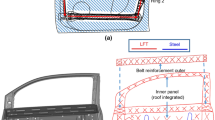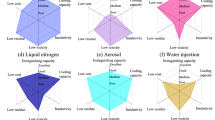Abstract
The specific distribution characteristics of inclusions along with the sliver defect were analyzed in detail to explain the formation mechanism of the sliver defect on the automobile exposed panel surface. A quantitative electrolysis method was used to compare and evaluate the three-dimensional morphology, size, composition, quantity, and distribution of inclusions in the defect and non-defect zone of automobile exposed panel. The Al2O3 inclusions were observed to be aggregated or chain-like shape along with the sliver defect of about 3–10 µm. The aggregation sections of the Al2O3 inclusions are distributed discretely along the rolling direction, with a spacing of 3–7 mm, a length of 6–7 mm, and a width of about 3 mm. The inclusion area part is 0.04%–0.16% with an average value of 0.08%, the inclusion number density is 40 mm−2 and the inclusion average spacing is 25.13 µm. The inclusion spacing is approximately 40–160 µm, with an average value of 68.76 µm in chain-like inclusion parts. The average area fraction and number density of inclusions in the non-defect region were reduced to about 0.002% and 1–2 mm−2, respectively, with the inclusion spacing of 400 µm and the size of Al2O3 being 1–3 µm.
Similar content being viewed by others
References
M. Wang and Y.P. Bao, Source and negative effects of macroinclusions in titanium stabilized ultra low carbon interstitial free (Ti-IF) steel, Met. Mater. Int., 18(2012), No. 1, p. 29.
Q.Y. Zhang, L.T. Wang, and X.H. Wang, Influence of casting speed variation during unsteady continuous casting on nonmetallic inclusions in IF steel slabs, ISIJ Int., 46(2006), No. 10, p. 1421.
H. Esaka, Y. Kuroda, K. Shinozuka, and M. Tamura, Interaction between argon gas bubbles and solidified shell, ISIJ Int., 44(2004), No. 4, p. 682.
H. Yasunaka, R. Yamanka, T. Inoue, and T. Saito, Pinhole and inclusion defects formed at the subsurface in ultra low carbon steel, Tetsu-to-Hagané, 81(1995), No. 5, p. 529.
X.X. Deng, L.P. Li, X.H. Wang, Y.Q. Ji, C.X. Ji, and G.S. Zhu, Subsurface macro-inclusions and solidified hook character in aluminum-killed deep-drawing steel slabs, Int. J. Miner. Metall. Mater., 21(2014), No. 6, p. 531.
H. Yamamura, Y. Mizukami, and K. Misawa, Formation of a solidified hook-like structure at the subsurface in ultra low carbon steel, ISIJ Int., 36(1996), No. Suppl, p. S223.
X.X. Deng, C.X. Ji, Y. Cui, Z.H. Tian, X. Yin, X.J. Shao, Y.D. Yang, and A. McLean, Formation and evolution of macro inclusions in IF steels during continuous casting, Ironmaking Steelmaking, 44(2017), No. 10, p. 739.
J. Sengupta, B.G. Thomas, H.J. Shin, G.G. Lee, and S.H. Kim, A new mechanism of hook formation during continuous casting of ultra-low-carbon steel slabs, Metall. Mater. Trans. A, 37(2006), No. 5, p. 1597.
G.G. Lee, H.J. Shin, S.H. Kim, S.K. Kim, W.Y. Choi, and B.G. Thomas, Prediction and control of subsurface hooks in continuous cast ultra-low-carbon steel slabs, Ironmaking Steelmaking, 36(2009), No. 1, p. 39.
M. Zeze, A. Tanaka, and R. Tsujino, Formation mechanism of sliver-type surface defect with oxide scale on sheet and coil, Tetsu-to-Hagané, 87(2001), No. 2, p. 85.
T. Miyake, M. Morishita, H. Nakata, and M. Kokita, Influence of sulphur content and molten steel flow on entrapment of bubbles to solid/liquid interface, ISIJ Int., 46(2006), No. 12, p. 1817.
H.X. Yu, C.X. Ji, B. Chen, C. Wang, and Y.H. Zhang, Characteristics and evolution of inclusion induced surface defects of cold rolled IF sheet, J. Iron Steel Res. Int., 22(2015), No. Supplement 1, p. 17.
S. Das, S. Roy, S. Nayak, T. Bhattacharyya, and S. Bhatacharyya, Case study-Analysis of grayish stick type sliver in cold rolled strips, Eng. Fail. Anal., 44(2014), p. 95.
H. Cui, H.J. Wu, F. Yue, W.S. Wu, M. Wang, Y.P. Bao, B. Chen, and C.X. Ji, Surface defects of cold-rolled Ti-IF steel sheets due to non-metallic inclusions, J. Iron Steel Res. Int., 18(2011), Suppl. 2, p. 335.
C. Genzano, J. Madías, D. Dalmaso, J. Petroni, D. Biurrun, and G.D. Gresia, Elimination of surface defects in cold-rolled extra low carbon steel sheet, [in] the ISS 85th Steelmaking Conference, Nashville, 2002, p. 325.
P. Záhumenský and M. Merwin, Evolution of artificial defects from slab to rolled products, J. Mater. Process. Technol., 196(2008), No. 1–3, p. 266.
H. Utsunomiya, K. Hara, R. Matsumoto, and A. Azushima, Formation mechanism of surface scale defects in hot rolling process, CIRP Ann., 63(2014), No. 1, p. 261.
S. Moir and J. Preston, Surface defects—evolution and behaviour from cast slab to coated strip, J. Mater. Process. Technol., 125–126(2002), p. 720.
R. Inoue, K. Kiyokawa, K. Tomoda, S. Ueda, and T. Ariyama, Three dimensional estimation of multi-component inclusion particle in steel, Metall. Anal., 32(2012), No. 8, p. 1.
D. Janis, R. Inoue, A. Karasev, and P.G. Jönsson, Application of different extraction methods for investigation of nonmetallic inclusions and clusters in steels and alloys, Adv. Mater. Sci. Eng., 2014(2014), art. No. 210486.
Y.P. Bao, M. Wang, and W. Jiang, A method for observing the three-dimensional morphologies of inclusions in steel, Int. J. Miner. Metall. Mater., 19(2012), No. 2, p. 111.
X.W. Zhang, L.F. Zhang, W. Yang, Y. Wang, Y. Liu, and Y.C. Dong, Characterization of the three-dimensional morphology and formation mechanism of inclusions in linepipe steels, Metall. Mater. Trans. B, 48(2017), No. 1, p. 701.
J. Guo, S.S. Cheng, H.J. Guo, and Y.G. Mei, Determination of non-metallic inclusions in a continuous casting slab of ultra-low carbon interstitial free steel by applying of metallographic method, electrolytic method and RTO technique, Sci. Rep., 9(2019), art. No. 2929.
R. Inoue, S. Ueda, T. Ariyama, and H. Suito, Extraction of nonmetallic inclusion particles containing MgO from steel, ISIJ Int., 51(2011), No. 12, p. 2050.
R. Inoue, R. Kimura, S. Ueda, and H. Suito, Applicability of nonaqueous electrolytes for electrolytic extraction of inclusion particles containing Zr, Ti, and Ce, ISIJ Int., 53(2013), No. 11, p. 1906.
R. Diederichs and W. Bleck, Modelling of manganese sulphide formation during solidification, part I: Description of MnS formation parameters, Steel Res. Int., 77(2006), No. 3, p. 202.
R. Diederichs, R. Bülte, G. Pariser, and W. Bleck, Modelling of manganese sulphide formation during solidification, Part II: Correlation of solidification and MnS formation, Steel Res. Int., 77(2006), No. 4, p. 256.
Q.C. Peng, J.L. Yang, S. Peng, X.H. Zhang, S.P. Tang, and Y.S. Tian, Analysis of linear defects of cold-rolled galvanized sheet, Adv. Mater. Res., 652–654(2013), p. 2034.
Acknowledgements
This work was financially supported by the National Natural Science Foundation of China (No. U1960202).
Author information
Authors and Affiliations
Corresponding author
Rights and permissions
About this article
Cite this article
Pan, Xq., Yang, J., Park, J. et al. Distribution characteristics of inclusions along with the surface sliver defect on the exposed panel of automobile: A quantitative electrolysis method. Int J Miner Metall Mater 27, 1489–1498 (2020). https://doi.org/10.1007/s12613-020-1973-8
Received:
Revised:
Accepted:
Published:
Issue Date:
DOI: https://doi.org/10.1007/s12613-020-1973-8




